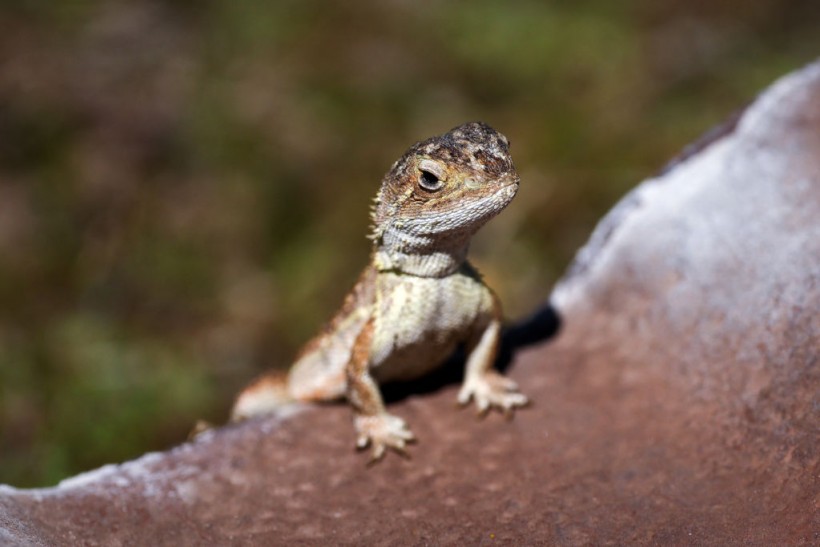Forests are the lungs of our planet, teeming with life and playing a vital role in regulating the Earth's climate. But for many lizard species, trees are more than just a part of the scenery - they are essential for their very survival.
A recent study by scientists at the University of California, Berkeley has shed light on the devastating impact of deforestation on lizard populations.
The study found that lizards rely on trees to regulate their body temperature, and with the disappearance of the forest canopy, they are struggling to survive in the harsher conditions.
When the Canopy Disappears, So Do Lizards: The Devastating Impact of Deforestation

(Photo : DAVID GRAY/AFP via Getty Images)
Lizards are cold-blooded reptiles, meaning they cannot generate their own body heat.
They rely on external sources to maintain their optimal body temperature range, which is crucial for their metabolism, digestion, and activity levels. Trees play a critical role in this process by providing shade and cooler microclimates.
During the hot midday sun, lizards can retreat to the shade of the trees to avoid overheating. Conversely, on cooler mornings, they can bask in patches of sunlight filtering through the leaves to warm up.
The loss of trees due to deforestation has a direct impact on the ability of lizards to regulate their body temperature. With the canopy gone, they are exposed to the full force of the sun, leading to overheating and potentially fatal consequences.
A study published in the journal "Nature Climate Change" found that lizards in deforested areas experienced body temperatures that were significantly higher than those in forested areas.
This rise in body temperature can lead to a cascade of physiological problems, including dehydration, organ failure, and even death.
The consequences of deforestation go beyond just the immediate impact on lizard populations. Lizards play a vital role in the ecosystem as predators of insects and other invertebrates.
Their decline can lead to an increase in pest populations, which can have cascading effects on the entire food chain. For example, a study in Borneo found that the loss of lizards due to deforestation led to an increase in the population of termites, which in turn damaged trees and contributed to further deforestation.
Also Read: Climate Change and Lizards: Reproduction Strategy May Need to Change, Researchers Say
A Race Against Time: Saving the Earless Dragon from Extinction
The plight of the earless dragon, a small lizard native to Australia, serves as a stark reminder of the devastating consequences of habitat loss. With only eleven individuals remaining in the wild, this charismatic creature is teetering on the brink of extinction.
The primary threat to the earless dragon is the loss of its grassland habitat due to agricultural development and urbanization.
These activities have fragmented and destroyed the grasslands where the earless dragon makes its home, leaving the remaining population isolated and vulnerable.
Additionally, earless dragons are insectivores, and the use of pesticides in agriculture has reduced the availability of their prey.
Climate change is another major threat to the earless dragon. The increasing frequency and intensity of droughts are putting stress on the already fragile grasslands where the earless dragon lives.
Additionally, rising temperatures can make it difficult for earless dragons to regulate their body temperature, as discussed earlier.
Invasive species are also a threat to the earless dragon. Feral cats and foxes prey on earless dragons, and cane toads, a poisonous amphibian introduced to Australia, compete with earless dragons for food and resources.
Scientists are racing against time to save the earless dragon from extinction. A captive breeding program has been established in an attempt to bolster the wild population.
However, the long-term success of this program hinges on the preservation of suitable habitat for the reintroduction of captive-bred individuals. Conservation efforts are also underway to address the threats posed by climate change, invasive species, and habitat loss.
The story of the earless dragon is a cautionary tale that highlights the urgent need to protect endangered species and their habitats.
By raising awareness about the threats posed by deforestation and habitat loss, we can take steps to ensure the survival of these remarkable creatures for generations to come.
Related article: Asian Water Monitor Lizards Thought Nearly Extinct in China Caught on Camera for the First Time After a Decade
© 2024 NatureWorldNews.com All rights reserved. Do not reproduce without permission.



![Climate Change is Reducing Dust Levels Worldwide as Arctic Temperature Warms [Study]](https://1471793142.rsc.cdn77.org/data/thumbs/full/70320/280/157/50/40/climate-change-is-reducing-dust-levels-worldwide-as-arctic-temperature-warms-study.jpg)

